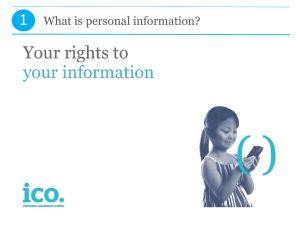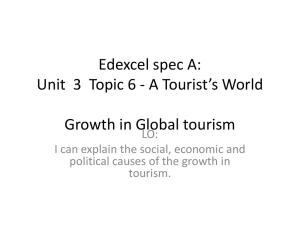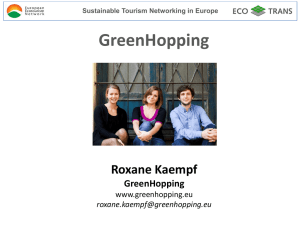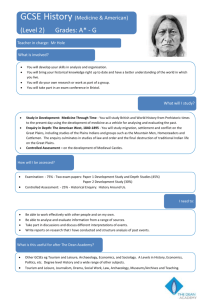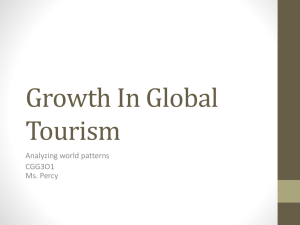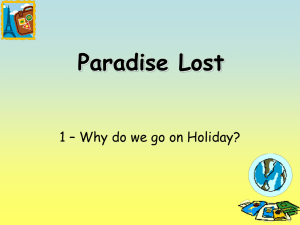Revision Videos
advertisement
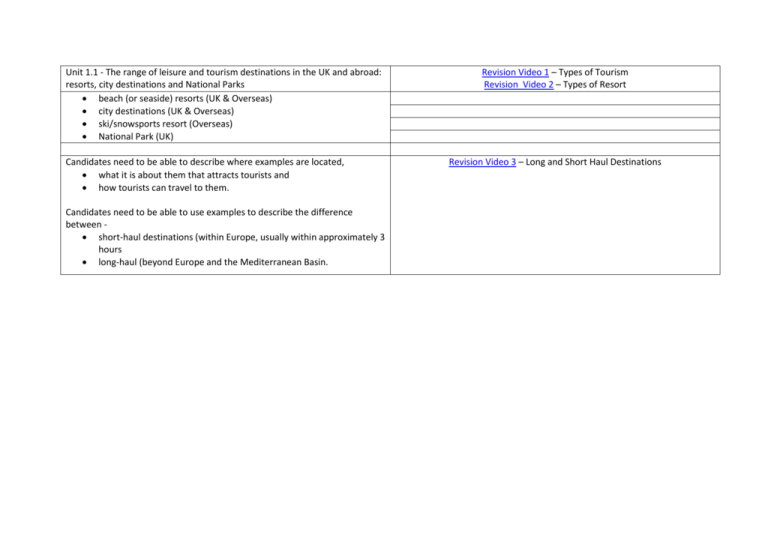
Unit 1.1 - The range of leisure and tourism destinations in the UK and abroad: resorts, city destinations and National Parks beach (or seaside) resorts (UK & Overseas) city destinations (UK & Overseas) ski/snowsports resort (Overseas) National Park (UK) Candidates need to be able to describe where examples are located, what it is about them that attracts tourists and how tourists can travel to them. Candidates need to be able to use examples to describe the difference between short-haul destinations (within Europe, usually within approximately 3 hours long-haul (beyond Europe and the Mediterranean Basin. Revision Video 1 – Types of Tourism Revision Video 2 – Types of Resort Revision Video 3 – Long and Short Haul Destinations Unit 1.2 - How people choose which destinations to visit Candidates need to be able to explain how the following factors can affect people’s destination choices: • the range of products and services on offer • weather and climate • personal interests and taste • cost • accessibility • the promotion of destinations, including by organisations such as transport and accommodation providers, tour operators and travel agents • events. Revision Video 4 – Factors affecting destination choices Unit 1.3 - Visitor attractions in the UK and abroad and the activities they offer, including how these appeal to different visitor types Candidates must learn about at least one UK and one overseas example of each of: • natural attractions – physical features such as waterfalls, mountains and valleys that attract visitors • historic sites – places such as ancient monuments and old buildings that have become attractions for visitors • theme parks – large attractions including rides that are spread over a large site • major sports/entertainment venues – nationally important sports or entertainment facilities such as stadia, arenas and theatres • built attractions – facilities such as museums, and galleries that have been specifically built to attract visitors. Candidates need to be able to describe the range of leisure activities available at each of these attractions and to describe and explain why the attractions try to meet the needs of different customer types and how successfully this is done. Candidates need to be able to apply their knowledge and understanding to explain how a visitor attraction they have not studied seeks to attract different customer types. Different types of leisure and tourism customer: • single people • couples • families with children • groups travelling together • different age groups: children, teenagers, young adults, mature adults, retired people • different ethnic and cultural groups • people with special needs. Unit 1.4 - The methods (modes) of travel available to leisure and tourism destinations and attractions and why people choose them Candidates need to learn about the various means of travel available to leisure and tourism destinations and attractions. They need to be able to explain why some travel options may be more likely to appeal to some customers than others. They need to learn about principal transport modes, routes, terminals and gateways used by domestic and international tourists to move around, enter and leave the UK, as well as to the destination Candidates need to be able to explain the advantages and disadvantages of these, for different types of customers and journeys, in terms of: • cost • convenience and comfort • accessibility • relative environmental impact Revision Video 5 – Types of transport Unit 1.5 - The range of impacts leisure and tourism can have on communities and on the environment, the importance of sustainability in leisure and tourism and the meaning and aims of ecotourism. Candidates must learn about tourism’s positive and negative impact on • destination communities (their economic wellbeing and ways of life) • the environment both at destinations and because of travel to destinations. Candidates need to be able to classify tourism impacts as economic, social and environmental and to explain what each means. They need to be able to describe and explain examples of the impacts caused by tourism on a leisure and tourism destination. Candidates need to be able to explain what sustainability is and why it is important in leisure and tourism in the UK and internationally. They need to be able to explain the meaning and aims of ecotourism. Unit 2.1 - Candidates need to be able to explain what leisure is. Leisure activities that candidates need to learn about are: Unit 2.2 – Why people use leisure and tourism facilities 2.1.1 – Leisure Activities 2.1.2 – Sport & Physical Recreation 2.1.3 – Entertainment and attractions 2.1.4 – Eating out and Socialising 2.1.5 – Home based and special interest 2.1.6 – What is tourism? 2.1.7 – Leisure Tourism & VFR 2.1.8 – Business Tourism 2.1.9 – Why do people use Leisure and Tourism Facilities? 2.1.10 – Leisure and Tourism – same or different? Unit 2.3 – Different types of leisure and tourism organisations and facilities 2.3.1 – Leisure in a place 2.3.2 – Leisure and Tourism in rural areas 2.3.3 – Suburban Leisure and Tourism 2.3.4 – City Centre Leisure and Tourism 2.3.5 - Overseas Destinations – Leisure and Tourism 2.3.6 – Types of Leisure and Tourism Organisations 2.3.7 – Investigating local leisure and tourism organisation 2.3.8 – Facilities provided by a leisure and tourism organisation 2.3.9 – Leisure and Tourism organisations in multiple places 2.3.10 –The breadth of leisure Unit 2.4 –UK’s rapidly changing leisure and tourism industry 2.4.1 – Changes to provision in a local area 2.4.2 – Local changes and national trends 2.4.3 – Changing travel opportunities Revision Video – Types of L & T Revision Video – Why people choose & Types of organisation 2.4.4 – Holiday booking changes 2.4.5 – Change and the UK travel and tourism industry 2.4.6 – Leisure and tourism and the environment 2.4.7 – Need for sustainability 2.4.8 – Growth of ecotourism 2.4.9 – How much change? Unit 2.5 – Leisure and Tourism organisations as a business Revision Video – How Tourist Businesses operate 2.5.1 – Tourist businesses 2.5.2 – Promoting products and services 2.5.3 – Attitudes and cultures 2.5.4 – Health and Safety 2.5.5 – Promotion and sales 2.5.6 – Promotional Materials used by tourist businesses 2.5.7 – Promotional materials used by leisure and tourism organisations 2.5.8 – Market segmentation 2.5.9 – Target Markets 2.5.10 – Targeted Promotions 2.5.11 – Health & Safety matters 2.5.12 – Dealing with Health and Safety Unit 2.6 – Range of Employment opportunities in the Leisure and Tourism industry 2.6.1 – Range of Leisure and Tourism jobs 2.6.2 – Local Leisure jobs 2.6.3 – Travel and Tourism employment opportunities 2.6.4 – Resort reps 2.6.5 – Duties 2.6.6 – Skills and qualities 2.6.7 – Qualities count 2.6.8 – Working in leisure and tourism Revision Video – Jobs and opportunities in the tourist industry
